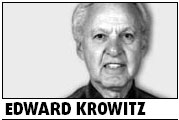In economics, there's no such thing as a free lunch
Updated: 2007-07-25 16:26
 The author Edward Krowitz is a retired US foreign service economist and former consultant to financial institutions
The author Edward Krowitz is a retired US foreign service economist and former consultant to financial institutions
In the fantasyland of my wasted youth, dreams of sudden fortune and unheard of good luck spilled out, one upon another - a lottery jackpot worth millions; unheard of happiness and wealth; the goddesses and gods of serendipity ruled this dreamland. Into this bubble a tiny gnomic figure burst.
An economist named Milton Friedman insisted to everyone's derisive hooting that there was no free lunch. One could not get something for nothing.
This insight was not evident to everyone. On the blackboards of some academic economists, periods of sharp increases in prices seemed to go together with higher output and lower unemployment. Especially in the post World War II era, increases in the price level were associated with increases in real output, which in turn seemed to lead to lower unemployment levels - the so-called Phillips curve.
For a few years, this became the fashion until the run-away inflation of in the late 1960s and early 70s intervened and the logic of Friedman's argument became evident. Attempts to trade off lower unemployment for higher inflation consistently led to an accelerating rise in prices over time. Increases in employment and output that did occur were soon eaten up by price increases. These factors combined with public expectations of further inflation made for an unstable economy that tumbled into boom and bust cycles of "stop and go". Ben Bernanke, the US Federal Reserve chairman summed up the experience nicely when he observed that policies based on the notion that inflation can promote employment growth have led to very bad outcomes whenever they have been applied.
Acceptance of the limits imposed by a non-accelerating inflation rate of unemployment for the economy came to be widely accepted. Pushing for a faster growth than could be accommodated only led to cyclical instability.
Yet a hardcore band of true believers in the Phillip's curve persists, led by a cheerleading squad of spokesmen for Western financial interests in China. They make periodic appearances in the pages of the China Daily ("we have a goldilocks economy, neither too hot nor too cold, but growing just right" 20 June 2007, p.10, but also refuted in editorials).
Their fantasies of a no-fault, no-cost inflation, discredited and rejected on their home turf have flourished in the heady sybaritic lifestyle of the roaring Asian tigers. Blissfully unaware of the tragedies of hyperinflation littering Chinese economic history, this fantasy continues to be peddled to the unwary.
The enthusiasts insist additional investments, spurring additional economic activity in excess of the economy's potential capacity can cure poverty by putting the unemployed to work. They seem not to notice the most obvious signs of natural limits to sudden growth, that increasing production and supplies cannot instantaneously expand to meet demand but often proceed at an irritatingly slow pace in overcoming structural obstacles, such as an untrained labor force, transport and material bottlenecks, and the financial counterparts mirrored in asset price inflation in the real estate and stock markets, the increases in banks' excess reserves and the siphoning of savings into speculative outcomes. While churning economic activity might generate profits for some businesses, it is bad for staying on a stable growth path for the country.
Most fairy tales are contrived to end happily. But even for the delusional there is no free lunch. In the world outside of make believe, realism is the final end state, realized it is to be hoped before the fall rather than after a bust.
|
|